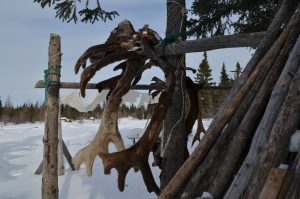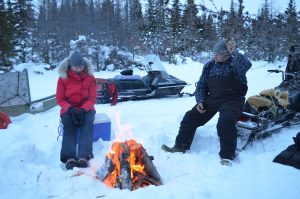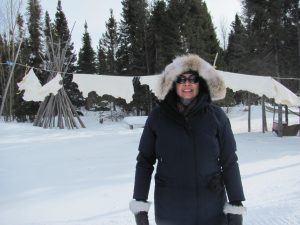By: Professor Dayna Nadine Scott, with Donna Ashamock (MoCreebec) and John Cutfeet (Kitchenuhmaykoosib Inninuwug).
In February, we were invited to visit Peawanuck, a Cree community in northern Ontario near the shores of Hudson Bay. Upon arrival, we were immediately struck by the evidence around us of people living off the land -- caribou hides and animal furs hung in the yards, many homes had teepee smokehouses, and people travelled by skidoos with boxed sleighs to carry food harvested from the land.
Peawanuck is the home community of the Weenusk First Nation and — like many Indigenous communities across northern Ontario — it is confronting the realities of a changing climate, increasing pressure from mining companies that want to extract minerals from their lands, and new land-use planning regimes flowing from the province. As part of our SSHRC-funded project “Consent and Contract: Authorizing Extraction on Indigenous Lands”, we went to Peawanuck to learn about how land-use decisions – traditional and contemporary - are made on the ground in the face of these pressures. The larger context, of course, is one in which Indigenous communities are drawing on UNDRIP to increasingly voice their rights to free, prior and informed consent (FPIC), in respect of decisions affecting their homelands.
We spoke with community leaders, Band staff, youth and elders. The striking message from all of these encounters is that the people of Peawanuck are effective stewards and fierce defenders of their lands. But this community — like others — is having to make crucial decisions that will affect people’s ability to fulfill these roles into the future.

Photo Credit: John Cutfeet
Under the Far North Act, which came into effect in 2011, the province hoped to integrate planning towards its environmental, social and economic goals in the region. Conservation, for example, was a major driver as major environmental groups recognize the value of the region as a carbon sink, and as crucial habitat for iconic species, such as Woodland Caribou.
However, the act was brought in despite the widespread opposition of people in the North, including the Nishnawbe Aski Nation, which represents the Weenusk and 48 other First Nations.
Under the Act, communities are asked to create community-based land-use plans that map out in detail the historical and contemporary uses of various parts of their territories. They can designate areas of significant cultural value such as burial sites, waterways and travel routes to be protected, caribou migration routes and areas to be considered open for — or closed to — mineral exploration.
The invitation to engage in mapping is not controversial; many communities were doing this anyway. But, under the Far North Act, the community-based land-use plans must be jointly approved by the First Nation and the Ministry of Natural Resources and Forestry (MNRF). Once the final plan is approved, all decisions to authorize land-use activities must be “consistent with” the land-use designations specified in the plan. Thus, for many people in the north, it is the inherent jurisdiction over lands and the authority to make decisions about contested land-uses that is at stake.
Communities have complex and nuanced mechanisms for authorizing various activities on the land and these rely on their own laws: Different family groups have authority over different parts of the territory based on the locations of harvesting areas, traplines, hunting camps and cabins.
In Peawanuck, we heard about the protocols that exist in Cree law for allowing access to outsiders, for sharing and for managing conflict. A vast pool of knowledge resides in the elders about how those principles apply and where.
The ability to make decisions about how the land is used across their territory is an authority they have always exercised in practice, if not under colonial law. When we asked elders in Peawanuck where they derive the authority to make decisions about land use in their territory, one responded: “The Creator gave it to us, to use … I will never forget the people who taught me that.”
Part of what the MNRF must hope to accomplish with the land-use planning exercise is to gain access to all of that knowledge — and then to bring the community’s authority to make decisions, its de facto governance of this land — under the MNRF’s jurisdiction.
And as a result, communities are concerned and confused. What are the consequences of not engaging in a land-use planning process under the Act? Some say the MNRF has told them that if they don’t produce a plan, one will be produced for them. Others say they fear that other communities’ interests will be prioritized over theirs.
Much of this is uncertain — but it is clear that funds to engage in the traditional land-use mapping exercise and for documenting the elders knowledge are available only to those Bands that agree to surrender to the MNRF process. (It is possible, however, for Bands to withdraw at the end of any of the prescribed five stages.) According to provincial law, any "development" would have to be approved by Minister’s order if no community-based land-use plan is in place.
"It is the people's land"
To the community elders, it feels like just the latest in a long string of sharp dealings that the “white man” has engaged in to rob them of their homelands.
As one elder stated forcefully to us, “It is our land, and we will keep it for our future grandchildren.” To do so, communities will need to stand strong against this process. It is a prime example of the contemporary state imperative that Shiri Pasternak describes in her recent book, "Grounded Authority": “To replace the sources of Indigenous law with a delegated authority of the Crown through the machinery of state jurisdiction."
In Peawanuck, it is obvious that the deep knowledge and respect for the land, and the authority to govern it, should go together. The message we heard loud and clear was, “It is the people’s land.”

Professor Dayna Scott alongside Sam Hunter, one of their Peawanuck hosts. Photo Credit: John Cutfeet

Donna Ashamock, Photo Credit: John Cutfeet

